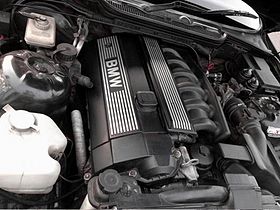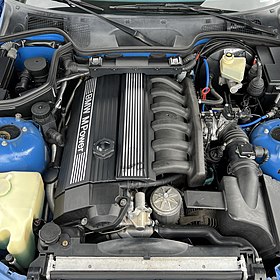BMW M52
| BMW M52 engine | |
|---|---|
 M52B28 in a E36 328i | |
| Overview | |
| Production | 1994–2000 |
| Layout | |
| Configuration | Straight-6 |
| Displacement | 2.0–2.8 L (122–171 cu in) |
| Cylinder bore | 80–84 mm (3.1–3.3 in) |
| Piston stroke | 66–84 mm (2.6–3.3 in) |
| Cylinder block material | Aluminium / cast iron |
| Cylinder head material | Aluminium |
| Valvetrain | DOHC, with VVT |
| Valvetrain drive system | Chain |
| Combustion | |
| Fuel type | Gasoline |
| Chronology | |
| Predecessor | BMW M50 |
| Successor | BMW M54 |
The BMW M52 is a straight-6 DOHC petrol engine which was produced from 1994 to 2000. It was released in the E36 320i,[1] to replace the M50. The BMW S52 engine is a high performance variant of the M52 which powered the American and Canadian market E36 M3 from 1996 to 1999.
In 1998, the "technical update" (M52TU) upgrades included adding variable valve timing to the exhaust camshaft.
The M52 was replaced by the M54 in the year 2000. The M52 and S52 engines were on the Ward's 10 Best Engines list from 1997 to 2000.[2]
Design[edit]
In most markets, the M52 switched from the M50's cast iron engine block to a lightweight aluminium engine block. However, most M52 engines produced for the United States and Canadian markets (except for those used by the BMW Z3 roadster) retained the M50's cast iron engine block,[3][4] while other cars used the new aluminum M52 block with iron sleeves.[3]
The largest version of the M52 is 2.8 litres, compared with 2.5 litres for the M50. As per the later versions of the M50, the M52 uses variable valve timing on the intake camshaft (called "single-VANOS"). The redline remained at 6,500 rpm.
Technical Update versions[edit]
In 1998, the M52TÜ ("Technical Update") was released, adding variable valve timing to the exhaust camshaft (called "double VANOS"). Other upgrades included a new design throttle body with the ASC (traction control) motor built in and throttle cable override, revised coolant passages with an additional drain back passage and a new cooling system with push fit hoses and a separate expansion tank plus [5] a dual length intake manifold (called "DISA") and steel cylinder liners (in the aluminum block) carried over from the previous M52, these replacing Nikasil in March 1998.[6]
Models[edit]
| Engine | Displacement | Power | Torque | Years |
|---|---|---|---|---|
| M52B20 | 1,991 cc (121 cu in) | 110 kW (148 hp) at 5900 rpm |
190 N⋅m (140 lb⋅ft) at 4200 rpm |
1994–1998 |
| M52TÜB20 | 110 kW (148 hp) at 5900 rpm |
190 N⋅m (140 lb⋅ft) at 3500 rpm |
1998–2000 | |
| M52TÜB24 | 2,394 cc (146 cu in) | 135 kW (181 hp) at 5800 rpm |
240 N⋅m (180 lb⋅ft) at 3600 rpm |
1998–2000 |
| M52B25 | 2,494 cc (152 cu in) | 125 kW (168 hp) at 5500 rpm |
245 N⋅m (181 lb⋅ft) at 3950 rpm |
1995–1998 |
| M52TÜB25 | 125 kW (168 hp) at 5500 rpm |
245 N⋅m (181 lb⋅ft) at 3500 rpm |
1998–2000 | |
| M52B28 | 2,793 cc (170 cu in) | 142 kW (190 hp) at 5300 rpm |
280 N⋅m (210 lb⋅ft) at 3950 rpm |
1995–1998 |
| M52TÜB28 | 142 kW (190 hp) at 5500 rpm |
280 N⋅m (210 lb⋅ft) at 3500 rpm |
1998–2000 | |
| S52B32 | 3,152 cc (192 cu in) | 179 kW (240 hp) at 6000 rpm |
325 N⋅m (240 lb⋅ft) at 3800 rpm |
1996–2000 |
M52B20[edit]
A 1,991 cc (121 cu in) version was introduced in 1994. Bore is 80 mm (3.1 in) and stroke is 66 mm (2.6 in).[7] The compression ratio is 11.0:1.
Applications:
M52TÜB20[edit]
The "technical update" in 1998 included double VANOS, which improved low rpm torque.
Applications:
M52TÜB24[edit]
2.4 L. For Thai market only. The bore is 84 mm (3.3 in) and the stroke is 72 mm (2.8 in).
M52B25[edit]
A 2,494 cc (152 cu in) version introduced in 1995.[8] It produces 125 kW (168 hp). Bore is 84 mm (3.3 in) and stroke 75 mm (3.0 in). The compression ratio is 10.5:1.
Applications:
M52TÜB25[edit]
The "technical update" in 1998 included double VANOS, which improved low rpm torque.
Applications:
M52B28[edit]
The 2,793 cc (170 cu in) version of the M52 debuted in 1995. It has a bore of 84 mm (3.3 in), a stroke of 84 mm (3.3 in) and produces 142 kW (190 hp).[9] The compression ratio is 10.2:1.
Applications:
- 1995–1999 E36 328i, 328is
- 1995–1998 E39 528i
- 1995–1998 E38 728i, 728iL
- 1997–1998 E36/7 Z3 2.8
- 1997–2000 Land Rover Defender (South Africa only)
M52TÜB28[edit]
The "technical update" in 1998 included double VANOS, which improved low rpm torque.
Applications:
Nikasil problems with high sulfur fuels[edit]
The aluminum M52 engine received criticism in some markets with high levels of sulfur in the petrol during the late 1990s. Sulfur has a corrosive effect on Nikasil and led to many early M52 and M60 engines having premature bore-liner wear.[10][11][12] Countries with high sulfur fuel (such as the United States) received an iron block version of the M52 (except for the M52B28 in the Z3 which was an aluminium block), so the Nikasil problem does not apply to most M52 engines in these countries.[13]
Once the Nikasil coating was determined to be the cause of the problem, steel cylinder liners were used instead of the Nikasil coating.[14] Therefore, the M52TU engine was not affected by the Nikasil problem.[15]
S52[edit]
| BMW S52 engine | |
|---|---|
 An S52B32 in an e36/7 M Roadster | |
| Overview | |
| Production | 1996–2000 |
| Layout | |
| Configuration | straight-6 |
| Displacement | 3,152 cc (192 cu in) |
| Cylinder bore | 86.4 mm (3.40 in) |
| Piston stroke | 89.6 mm (3.53 in) |
| Cylinder block material | Cast iron |
| Cylinder head material | Aluminium |
| Valvetrain | DOHC, with VVT |
| Combustion | |
| Fuel type | Gasoline |
| Chronology | |
| Predecessor | BMW S50B30US |
| Successor | BMW S54 |
The S52 is a higher performance version of the M52, which replaced the S50B30US in the post-facelift (1996-1999) North American E36 M3.
Compared to the European-spec S50, the S52 is less powerful. The S52 also shares more in common with the regular M52 engine than the S50 did with the M50, for example sharing the engine block (cast iron, as per North American M52 engines) and cylinder head. Unique to the S52 is a bore of 86.4 mm (3.4 in) and stroke of 89.6 mm (3.5 in) for a total displacement of 3,152 cc. Compression ratio is 10.5:1. Other upgrades over the M52 include lighter camshafts (with increased lift and duration), valve springs and the exhaust system.[16][17]
The S52 produces 240 hp (179 kW) at 6,000 rpm and 236 lb⋅ft (320 N⋅m) of torque at 3,800 rpm.[18] The S52 has a redline of 7,000 rpm while the M52 has a 6,500 rpm redline.
Applications:
- 1996–1999 E36 M3 (Canada and United States only)
- 1998–2000 E36/7/8 Z3M (Canada and United States only)
See also[edit]
References[edit]
- ^ "3'E36 model selection". www.realoem.com. Retrieved 16 January 2018.
- ^ "Wards 10 best engine". Wardsauto.com. Retrieved 2012-11-23.
- ^ a b "BMW Classic - Recherche-Client". bmw-grouparchiv.de. Retrieved 20 March 2018.
- ^ "Engines". www.metricmechanic.com. Archived from the original on 2017-09-22. Retrieved 1 October 2017.
- ^ "Engine Management Systems – SIEMENS MS 42.0 Engine Control System" (PDF). p. 51. Archived from the original (PDF) on 2016-03-04. Retrieved 2015-09-27.
- ^ "The UnixNerd's Domain - BMW M50 M52 M54 Engines". Archived from the original on 2018-09-27. Retrieved 2015-10-16.
- ^ "BMW Heaven Specification Database | Engine specifications for M52 engines". Bmwheaven.com. Retrieved 2012-11-18.
- ^ "BMW Heaven Specification Database | Engine specifications for M52 engines". Bmwheaven.com. Retrieved 2012-11-18.
- ^ "BMW 328i, 1999 E46 technical specifications 96228". Carfolio.com. Retrieved 2012-11-18.
- ^ BMW World - Nikasil, Usautoparts.net, archived from the original on 2013-11-02, retrieved 2012-11-18
- ^ "The Nikasil Issue". BMW Classics. Retrieved 2012-11-18.
- ^ "Engine components / basic engine - Crankcase". bimmernut.com. Archived from the original on 2007-04-07. Retrieved 2016-09-01.
- ^ "BMW World - M52 Engine". Usautoparts.net. Archived from the original on 2012-06-04. Retrieved 2012-11-22.
- ^ Simon Worby, Lestac Ltd (2002). "The BMW Nikasil issue". lestac.co.uk. Archived from the original on 2005-03-06. Retrieved 2016-09-01.
- ^ "BMW World - Nikasil". Usautoparts.net. Archived from the original on 2013-11-02. Retrieved 2012-11-18.
- ^ "BMW S52 Engine". www.mywikimotors.com. Archived from the original on 2017-10-21. Retrieved 6 October 2017.
- ^ "Extreme Engine Tech: Building a BMW S52 – Part 1: The Short Block". www.motoiq.com. 14 May 2015. Retrieved 6 October 2017.
- ^ "FAQ E36/8 M coupe". BMW M Registry. Retrieved 2012-11-18.
